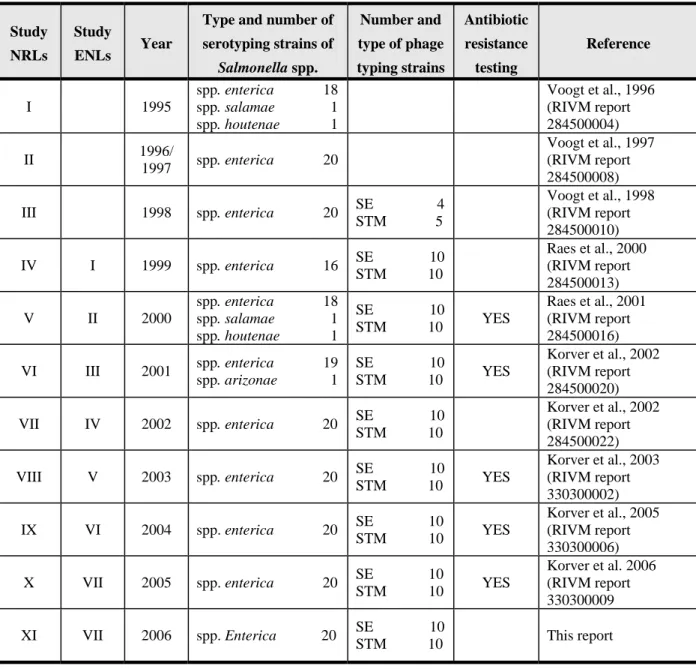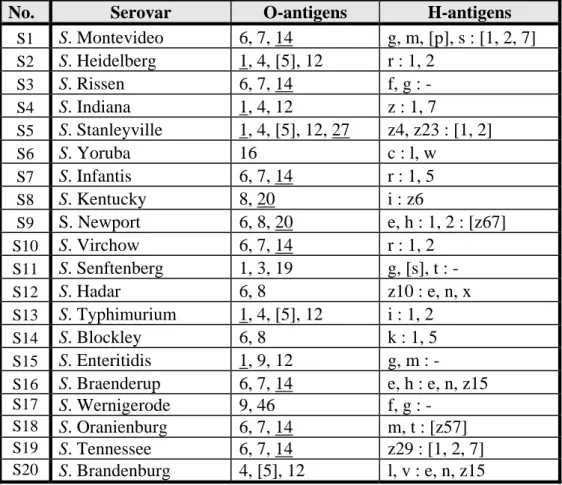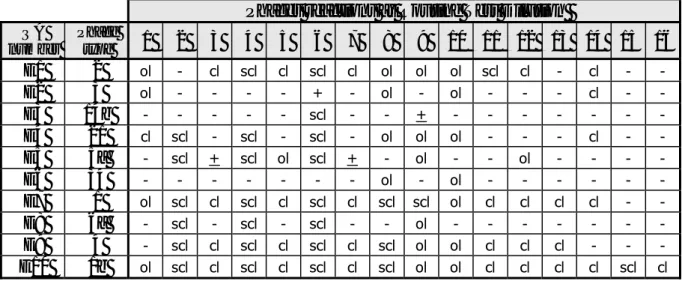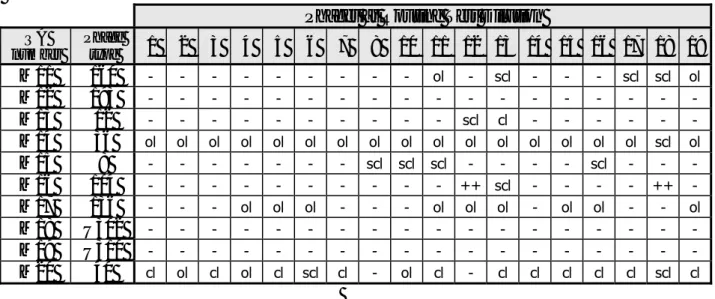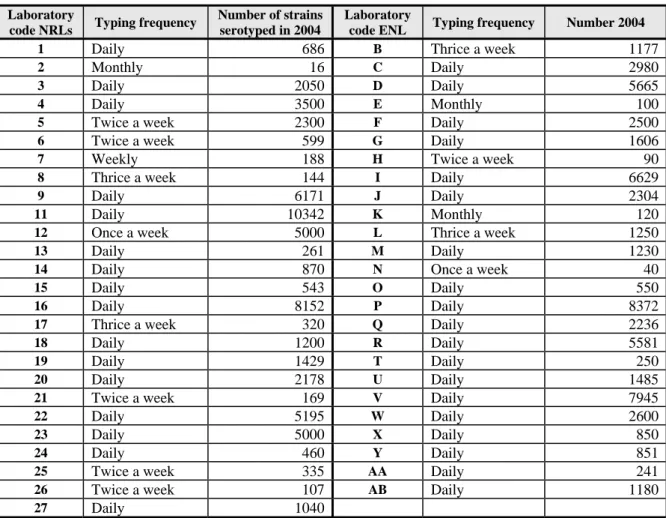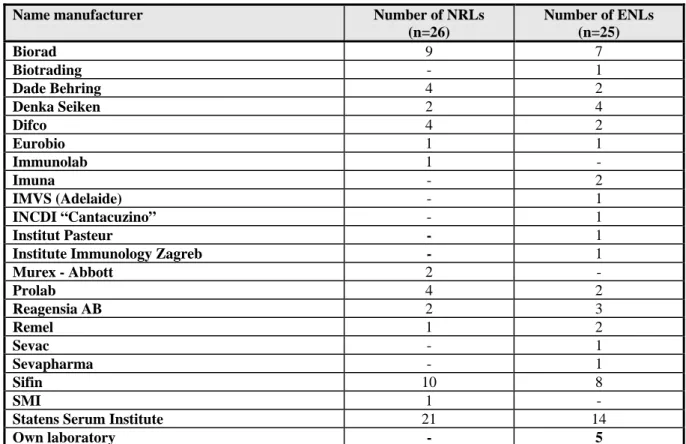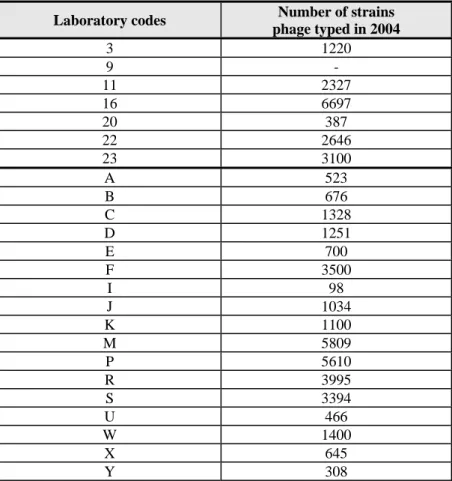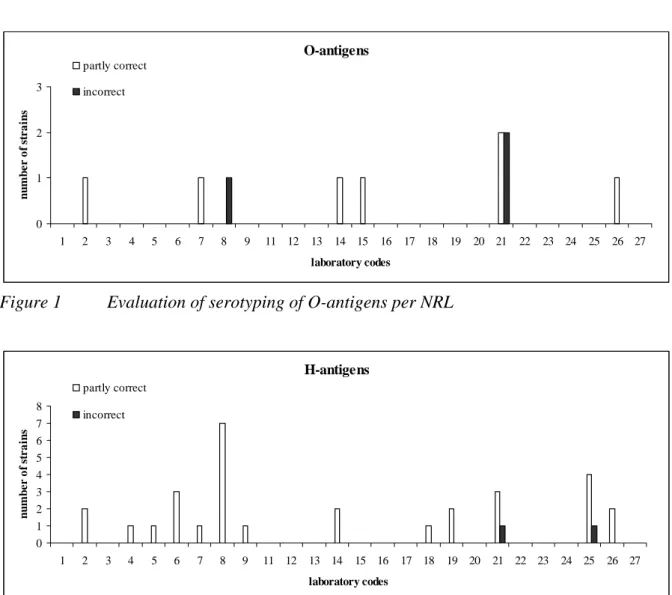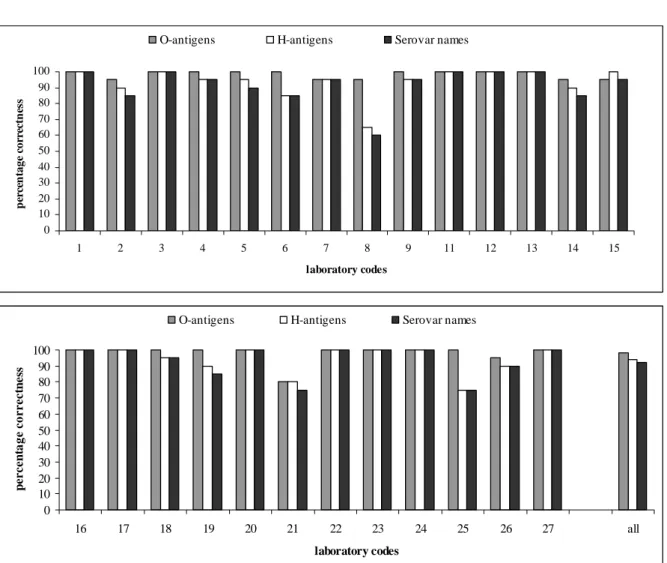RIVM report 330604001/2006
Eleventh CRL-Salmonella interlaboratory
comparison study (2006) on typing of Salmonella
spp.
P.A. Berk, H.M.E. Maas, E. de Pinna, K.A. Mooijman
Contact:
K. Mooijman
Microbiological Laboratory for Health Protection
(MGB)
Kirsten.Mooijman@rivm.nl
This investigation has been performed by order and for the account of the European
Commission, Legislation Vétérinaire et Zootechnique and the RIVM within the framework of
RIVM project E/330604/06/CS by the Community Reference Laboratory for Salmonella.
RIVM, P.O. Box 1, 3720 BA Bilthoven, telephone: 31 - 30 - 274 91 11; telefax: 31 - 30 - 274 29 71 European Commission, Legislation Vétérinaire et Zootechnique, Rue de la Loi 86, B-1049 Bruxelles, Belgique, telephone +32-2-2959 928; telefax: 32-2-2953 144
Abstract
Eleventh CRL-Salmonella interlaboratory comparison study (2006) on typing of
Salmonella spp.
The eleventh interlaboratory comparison study on the typing of Salmonella was organised by
the Community Reference Laboratory for Salmonella (CRL-Salmonella, Bilthoven, The
Netherlands) in collaboration with the Health Protection Agency (HPA, London, United
Kingdom) in March 2006. 26 National Reference Laboratories for Salmonella
(NRLs-Salmonella), including Norway, and 31 Enter-Net Laboratories (ENLs), three of which also
NRLs, participated in the study. In total, 20 strains of the species Salmonella enterica
subspecies enterica were selected for serotyping. 10 Strains of Salmonella Enteritidis (SE)
and 10 strains of Salmonella Typhimurium (STM) were selected for phage typing. In general,
no problems were encountered with the typing of the O-antigens. 98 % of the NRLs and 98 %
of the ENLs were able to correctly type the O-antigens. A few laboratories had problems
typing the H-antigens. The H-antigens were typed correctly by 94 % of the NRLs and by
94 % of the ENLs. 93 % of the NRLs and 93 % of the ENLs indicated correct serovar names
for the 20 serotyping strains. The phage typing results of the majority of the NRLs were
found to be good. The seven NRLs phage typed 94 % of the Salmonella Enteritidis strains
correct and 99 % of the Salmonella Typhimurium strains. 18 ENLs participated in the
phagetyping. The Salmonella Enteritidis strains were correctly phage typed by 84 % of the
ENLs and Salmonella Typhimurium by 89 % of the ENLs.
Rapport in het kort
Elfde CRL-Salmonella ringonderzoek (2006) voor de typering van Salmonella spp.
Het elfde ringonderzoek voor de typering van Salmonella werd in maart 2006 georganiseerd
door het Communautair Referentie Laboratorium voor Salmonella (CRL-Salmonella,
Bilthoven, Nederland) in samenwerking met de Health Protection Agency (HPA, Londen,
Verenigd Koninkrijk). 26 Nationale Referentie Laboratoria voor Salmonella
(NRLs-Salmonella) inclusief Noorwegen en 31 Enter-Net Laboratoria (ENLs), waarvan 3 ook NRL,
namen deel aan de studie. 20 Stammen van species Salmonella enterica subspecies enterica
werden geselecteerd voor de serotypering. Tien stammen van Salmonella Enteritidis (SE) en
10 stammen van Salmonella Typhimurium (STM) werden geselecteerd voor faagtypering. In
het algemeen werden geen problemen gevonden met de typering van de O-antigenen. 98 %
procent van de NRLs en
98 % van de ENLs typeerden de O-antigenen correct. Slechts enkele
laboratoria hadden problemen met het typeren van de H-antigenen. De H-antigenen werden
correct getypeerd door 94 % van de NRLs en door 94 % van de ENLs. 93 % procent van de
NRLs en 93 % van de ENLs gaven de 20 serotyperingsstammen de goede serovar naam. De
meeste NRLs vonden goede resultaten met de faagtypering. De zeven NRLs faagtypeerden
94 % van de Salmonella Enteritidis stammen correct en 99 % van de Salmonella
Typhimurium stammen. De achttien ENLs hebben 84 % van de Salmonella Enteritidis en
89 % van de Salmonella Typhimurium stammen goed gefaagtypeerd
Contents
Summary 7
List of abbreviations 8 1 Introduction 9 2 Participants 11
3 Materials and Methods 15
3.1 Salmonella strains for serotyping 15 3.2 Salmonella strains for phage typing 16
3.3 Laboratory codes 17
3.4 Transport 18
3.5 Guidelines for evaluation of serotyping results 18
4 Questionnaire 19
4.1 General questions 19
4.2 Questions regarding serotyping 20
4.3 Questions regarding phage typing 22
5 Results 23
5.1 Serotyping by the NRLs-Salmonella 23
5.1.1 Evaluation per laboratory 23 5.1.2 Evaluation per strain 25
5.2 Serotyping by the ENLs 28
5.2.1 Evaluation per laboratory 28 5.2.2 Evaluation per strain 30
5.3 Results phage typing 32
5.3.1 Results phage typing by the NRLs-Salmonella 32 5.3.2 Results phage typing by the ENLs 34
6 Discussion 37 7 Conclusions 39 References 41
Annex 1
Protocol 43 Annex 2. Testreport 46
Summary
In 2006 the eleventh interlaboratory comparison study on typing of Salmonella was organised
by the EU Community Reference Laboratory for Salmonella (CRL-Salmonella, Bilthoven,
the Netherlands) in collaboration with the Health Protection Agency (HPA, London, United
Kindom). The main objective of the study was to evaluate whether examination of samples
by the National Reference Laboratories (NRLs-Salmonella) as well as by the EnterNet
Laboratories (ENLs) was carried out uniformly and whether comparable results were
obtained.
25 NRLs-Salmonella of the Member States of the European Union participated, as well as
NRL-Norway. Furthermore, 31 EnterNet laboratories participated, 3 of them are also NRLs.
All 26 NRLs and 28 ENLs performed serotyping. A total of 20 strains of the species
Salmonella enterica subspecies enterica were selected for serotyping by the
CRL-Salmonella. The strains had to be typed with the method routinely used in each laboratory.
The laboratories were allowed to send strains for serotyping to another specialised laboratory
in their country. No, or very few problems were encountered with the typing of the
O-antigens. Some problems existed with the H-antigens, although the group of laboratories
facing these problems seem to diminish. 98 % of the NRLs and 98 % of the ENLs were able
to correctly type the O-antigens. The H-antigens were typed correctly by 94 % of the NRLs
and by
94 %
of the ENLs. 93 % of the NRLs and
93 %
of the ENLs indicated correct serovar
names for the 20 serotyping strains. Seven of the participating NRLs-Salmonella and
eighteen of the ENLs also performed phage typing. The HPA selected 20 strains for phage
typing, 10 were of the serovar Salmonella Enteritidis (SE) and 10 of the serovar Salmonella
Typhimurium (STM).
The phage typing results of the majority of the laboratories were good.
The seven NRLs phage typed 94 % of the Salmonella Enteritidis strains correct and 99 % of
the Salmonella Typhimurium strains. The Salmonella Enteritidis strains were correctly phage
typed by 84 % of the ENLs and Salmonella Typhimurium by 89 % of the ENLs.
List of abbreviations
BGA
Brilliant
Green
Agar
CLSI
Clinical
and
Laboratory
Standards
Insitute
CRL-Salmonella
Community Reference Laboratory – Salmonella
ENL
EnterNet
Laboratory
EU
European
Union
HPA
Health
Protection
Agency
LEP
Laboratory
of
Enteric
Pathogens
NRL-Salmonella
National Reference Laboratory – Salmonella
Nt
Not
typable
PT
Phage
Type
RIVM
National
Institute
for
Public Health and the Environment
RDNC
Reacts with phages but does not confirm to a recognized pattern
SD
Standard
Deviation
SE
Salmonella Enteritidis
STM
Salmonella Typhimurium
TSI
Triple
Sugar
Iron
agar
UK
United
Kingdom
XLT
Xylose
Lysine
Tergitol
1 Introduction
This report describes the 11
thinterlaboratory comparison study on the typing of Salmonella
strains. The study was organised by the Community Reference Laboratory for Salmonella
(CRL-Salmonella, Bilthoven, the Netherlands). According to the Regulation (EC) no
882/2004 it is one of the tasks of the CRL-Salmonella to organise interlaboratory comparison
studies for the National Reference Laboratories for Salmonella (NRLs-Salmonella). The main
objective is that the examination of samples in the Member States will be carried out
uniformly and comparable results will be obtained. The organisation of the typing studies
started in 1995. The history of the studies througth the years is shown in Table 1.
Table 1
History of interlaboratory comparison studies on typing of Salmonella spp
Study NRLs
Study
ENLs Year
Type and number of serotyping strains of Salmonella spp. Number and type of phage typing strains Antibiotic resistance testing Reference I 1995 spp. enterica 18 spp. salamae 1 spp. houtenae 1 Voogt et al., 1996 (RIVM report 284500004) II 1996/ 1997 spp. enterica 20 Voogt et al., 1997 (RIVM report 284500008) III 1998 spp. enterica 20 SE 4 STM 5 Voogt et al., 1998 (RIVM report 284500010) IV I 1999 spp. enterica 16 SE 10 STM 10 Raes et al., 2000 (RIVM report 284500013) V II 2000 spp. enterica 18 spp. salamae 1 spp. houtenae 1 SE 10 STM 10 YES Raes et al., 2001 (RIVM report 284500016) VI III 2001 spp. enterica 19 spp. arizonae 1 SE 10 STM 10 YES Korver et al., 2002 (RIVM report 284500020) VII IV 2002 spp. enterica 20 SE 10 STM 10 Korver et al., 2002 (RIVM report 284500022) VIII V 2003 spp. enterica 20 SE 10 STM 10 YES Korver et al., 2003 (RIVM report 330300002) IX VI 2004 spp. enterica 20 SE 10 STM 10 YES Korver et al., 2005 (RIVM report 330300006) X VII 2005 spp. enterica 20 SE 10 STM 10 YES Korver et al. 2006 (RIVM report 330300009 XI VII 2006 spp. Enterica 20 SE 10 STM 10 This report
26 NRLs-Salmonella and 31 EnterNet Laboratories (ENLs) participated in this tenth study, 3
of these ENLs are also NRLs and their results are shown with the other NRL results. The
main objective of this study was to compare the results of typing of Salmonella spp. among
the NRLs-Salmonella and among the ENLs. All NRLs and 26 ENLs performed serotyping of
the strains.
Seven of the NRLs-Salmonella and 18 ENLs performed phage typing on 10 Salmonella
Enteritidis and 10 Salmonella Typhimurium strains. However one ENL sent in their results
very late and therefore their results are not included in this report. The selection of the strains
and interpretation of the results of the phagetyping was performed in close cooperation with
the Health Protection Agency, London, UK.
2 Participants
Country
Institute/City
National Reference Laboratory for Salmonella (NRL) or EnterNet Laboratory (ENL)
Australia
University of Melbourne
Department of Microbiology and Immunology
Parkville
ENL
Austria
Institut für Medizinische Mikrobiologie und
Hygiene
Graz
NRL ENL
Belgium
Veterinary and Agrochemical Research Center
(VAR)
Brussels
NRL
Belgium
Institute Scientifique de Santé Publique
Section Bacteriologie
Brussels
ENL
Canada
Canadian Science Centre for Human and Animal
Health – National Microbiology Laboratory
Winnipeg
ENL
Cyprus
Laboratory for the Control of Foods of Animal
Origin (LCFAO)
Nicosia
NRL
Cyprus
Nicosia General Hospital
Microbiology Department
Nicosia
ENL
Czech Republic
National Reference Laboratory for
Salmonellosis, State Veterinary Institute
Prague
NRL
Czech Republic
National Reference Laboratory for Salmonella
National Institute of Public Health
Prague
ENL
Denmark
Danish Institute for Food and Veterinary
Research (DFVF)
Copenhagen
NRL
Denmark
Statens Serum Institut
Department of Gastrointestinal Infections
Copenhagen
ENL
Estonia
Estonian Veterinary and Food Laboratory
Diagnostic Department, Bacteriology Laboratory
Tartu
NRL
Finland
National Veterinary and Food Research Institute
Kuopio Department
Kuopio
NRL
Finland
National Public Health Institute (KTL)
Laboratory of Enteric Pathogens,
Helsinki
Country
Institute/City
National Reference Laboratory for Salmonella (NRL) or EnterNet Laboratory (ENL)
France
Agence française de sécurité sanitaire des
aliments (AFSSA), Laboratoire d’études et de
recherches avicoles et porcines (LERAP),
Ploufragan
NRL
France
Unité Biodiversité des Bacteries
Institute Pasteur
Paris
ENL
Germany
Federal Institute for Risk Assessment (BFR)
National Veterinary Salmonella Reference Lab.
Berlin
NRL
Germany
Robert-Koch Institut
Bereich Wernigerode
Harz
ENL
Greece
Veterinary Laboratory of Halkis
Halkis
NRL
Greece
National and Kapodistrian University of Athens
Department of Microbiology, Medical School
Athens
ENL
Hungary
National Food Investigation Institute of Hungary
Department Food Microbiology
Budapest
NRL
Hungary
Johan Bela National Centre for Epidemiology,
Department of Phage Typhing and Molecular
Epidemiology (phagetyping)
Budapest
ENL
Hungary
NCE, Department of Bacteriology II (serotyping)
Budapest
ENL
Ireland
Department of Agriculture and Food
Central Veterinary Research Laboratory
Dublin
NRL
Ireland
National Salmonella Reference Laboratory
University College Hospital
Galway
ENL
Italy
Istituto Zooprofilattico Sperimentale delle Venezie
Legnaro
NRL
Italy
Istituto Superiore di Sanita
Lab. of Medical Bacteriology & Mycology
Rome
ENL
Japan
National Institute of Infectious Diseases
Department of Bacteriology
Tokyo
ENL
Latvia
State Veterinary Medicine Diagnostic Centre
(SVMDC)
Riga
Country
Institute/City
National Reference Laboratory for Salmonella (NRL) or EnterNet Laboratory (ENL)
Lithuania
National Veterinary Laboratory
Vilnius
NRL
Luxembourg
Laboratoire de Médecine Vétérinaire de l’Etat
Animal Zoonosis
Luxembourg
NRL
Luxembourg
Laboratoire National de Santé
Luxembourg
ENL
Malta
St. Luke’s Hospital
Malta
ENL
The
Netherlands
National Institute for Public Health and the
Environment (RIVM)
Bilthoven
NRL ENL
New Zealand
ESR Kenepura Science Centre
Communicable Disease Group
Porirua
ENL
Northern
Ireland (UK)
Department of Agriculture for Northern Ireland
Veterinary Sciences Division, Bact. Department
Belfast
NRL
Norway
National Institute of Public Health
Oslo
NRL ENL
Poland
State Veterinary Institute
Microbiological Department
Pulawy
NRL
Portugal
Laboratório Nacional de Veterinária
Lisbon
NRL
Portugal
Instituto Nacional de Saude
Lisbon
ENL
Romania
INCDMI “Cantacuzino”
Molecular Epidemiology Laboratory
Bucharest
ENL
Scotland (UK)
Scottish Salmonella Reference Laboratory
Department of Bacteriology
Glasgow
ENL
Slovak
Republic
State Veterinary and Food Institute
Reference laboratory for Salmonella
Bratislava
NRL
Slovak
Republic
Slovak Medical University
Department of Microbiology (phagetyping)
Bratislava
ENL
Slovak
Republic
The Authority of Public Health of Slovak
Republic (serotyping)
Bratislava
Country
Institute/City
National Reference Laboratory for Salmonella (NRL) or EnterNet Laboratory (ENL)
Slovenia
National Veterinary Institute
Veterinary Faculty
Ljubljana
NRL
Slovenia
Institute of Public Health Celje
Department of Microbiology
Celje
ENL
Spain
Laboratorio de Sanidad Y Produccion Animal de
Algete
Madrid
NRL
Spain
Laboratorio de Enterobacterias, CNM
Instituto de Salud Carlos III
Madrid
ENL
Sweden
National Veterinary Institute
Department of Bacteriology
Uppsala
NRL
Sweden
Swedish Institute of Infectious Disease Control
Department of Bacteriology
Solna
ENL
Switzerland
Stv. Leiter Inst. Med. Mikrobiol.
Zentrum fur Labormedizin
Luzern
ENL
United
Kingdom
Veterinary Laboratories Agency Weybridge
Department of Bacterial Diseases
New Haw, Addlestone
NRL
United
Kingdom
Healty Protection Agency
3 Materials and Methods
3.1 Salmonella strains for serotyping
20 strains for serotyping were sent to the participants. The Salmonella strains used for the
interlaboratory comparison study on serotyping originated from the collection of the National
Salmonella Centre in the Netherlands. The strains were typed once again by this Centre before
mailing. The complete antigenic formula according to the most recent Kauffmann-White
scheme (Popoff, 2001) of the 20 serovars are shown in Table 2.
Table 2 Antigenic formulas of the 20 Salmonella strains according to the Kauffmann-White scheme determined by CRL-Salmonella
No.
Serovar
O-antigens
H-antigens
S1
S. Montevideo
6, 7, 14
g, m, [p], s : [1, 2, 7]
S2S. Heidelberg
1, 4, [5], 12
r : 1, 2
S3S. Rissen
6, 7, 14
f, g : -
S4S. Indiana
1, 4, 12
z : 1, 7
S5S. Stanleyville
1, 4, [5], 12, 27
z4, z23 : [1, 2]
S6S. Yoruba
16
c : l, w
S7S. Infantis
6, 7, 14
r : 1, 5
S8S. Kentucky
8, 20
i : z6
S9S. Newport
6, 8, 20
e, h : 1, 2 : [z67]
S10S. Virchow
6, 7, 14
r : 1, 2
S11S. Senftenberg
1, 3, 19
g, [s], t : -
S12S. Hadar
6, 8
z10 : e, n, x
S13S. Typhimurium
1, 4, [5], 12
i : 1, 2
S14S. Blockley
6, 8
k : 1, 5
S15S. Enteritidis
1, 9, 12
g, m : -
S16S. Braenderup
6, 7, 14
e, h : e, n, z15
S17S. Wernigerode
9, 46
f, g : -
S18S. Oranienburg
6, 7, 14
m, t : [z57]
S19S. Tennessee
6, 7, 14
z29 : [1, 2, 7]
S20S. Brandenburg
4, [5], 12
l, v : e, n, z15
3.2 Salmonella strains for phage typing
The strains of Salmonella for the comparison study on phage typing were from the collection
of the Salmonella Reference Unit of the Health Protection Agency (HPA), Laboratory of
Enteric Pathogens (LEP), National Salmonella Reference Laboratory for England and Wales,
London, UK. Ten strains of Salmonella Enteritidis and 10 strains of Salmonella
Typhimurium were selected.
The explanation of the various notations in Tables 3 and 4 and the Tables in Annex 3 are as
follows:
- = no
reaction
+ = 5-20
plaques
+ = 21-40
plaques
++ = 41-80
plaques
+++ =
81-100
plaques
scl = semi-confluent
lysis
cl
=
confluent clear lysis
ol
=
confluent opaque lysis
<<
=
merging plaques towards semi-confluent lysis
Table 3 Phage reactions of the Salmonella Enteritidis strains, determined by HPA
Phages reactions at Routine Test Dilution
QA number Phage type
1
2
3
4
5
6
7
8
9
10
11
12 13 14 15
16
E1 2
ol - cl scl cl scl cl ol ol ol scl cl - cl - -E2 3
ol - - - - + - ol - ol - - - cl - -E3 14b
- - - scl - - + - - -E4 21
cl scl - scl - scl - ol ol ol - - - cl - -E5 5a
- scl + scl ol scl + - ol - - ol - - - -E6 34
- - - ol - ol - - -E7 1
ol scl cl scl cl scl cl scl scl ol cl cl cl cl - -E8 6a
- scl - scl - scl - - ol - - - -E9 4
- scl cl scl cl scl cl scl ol ol cl cl cl - - -E10 1b
ol scl cl scl cl scl cl scl ol ol cl cl cl cl scl clTable 4 Phage reactions of the Salmonella Typhimurium strains, determined by HPA
Phages at Routine Test Dilution
QA number Phage type
1
2
3
4
5
6
7
8 10 11 12 13 14 15 16 17 18 19
M11 160
- - - ol - scl - - - scl scl olM12 193
- - -M13 12
- - - scl cl - - -M14 36
ol ol ol ol ol ol ol ol ol ol ol ol ol ol ol ol scl olM15 8
- - - scl scl scl - - - - scl - - -M16 104
- - - ++ scl - - - - ++ -M17 136
- - - ol ol ol - - - ol ol ol - ol ol - - olM18 U302
- - -M19 U310
- - -M20 40
cl ol cl ol cl scl cl - ol cl - cl cl cl cl cl scl clPhages at Routine Test Dilution
Additional phages
QA number Phage type
20 21 22 23 24 25 26 27 28 29 32 35
1
2
3 10
10
var
18
M11 160
scl - ol - - - scl - + + + ol ol -M12 193
- - - +++ +++ +++ ++ - -M13 12
- - - ++ ++ ++ ol ol -M14 36
ol ol ol ol ol ol ol ol ol ol ol ol + ++ ++ ol ol olM15 8
scl - ol scl - - ++ - - cl scl - + + + ol ol -M16 104
- - - ol ol -M17 136
+ - - - - scl - - - ol scl -M18 U302
- - - ol ol -M19 U310
- - - + ol -M20 40
cl ol ol cl cl scl cl cl - cl cl ol - + + ol ol ol3.3 Laboratory codes
The NRLs were assigned a laboratory code 1-27 by CRL-Salmonella, which differed from
the previous typing studies. From these 27 NRLs one laboratory did not participate and
therefore laboratory code 10 was not used. The alphabetical laboratory codes (A t/m Z and
AA and AB) for the ENLs were given by HPA, London, UK.
3.4 Transport
All samples were packed and transported as diagnostic specimens and transported by
door-to-door courier service. The parcels containing strains for serotyping for the NRLs were sent by
CRL-Salmonella in week 9, 2006. The parcels containing strains for phage typing for the
NRLs were sent by HPA, London, UK in week 9 and 10, 2006. The ENLs received all their
parcels from HPA.
3.5 Guidelines for evaluation of serotyping results
The evaluation of the various serotyping results as mentioned in this report are described in
Table 5.
Table 5
Evaluation of serotyping results
Results of serotyping
Evaluation
Auto agglutination
or incomplete set of antisera (outside the
range of antisera)
nt = not typable
Partly typable due to incomplete set of
antisera or part of the formula (for the name
of the serovar)
+/- = partly correct
4 Questionnaire
A questionnaire was incorporated in the testreport of the interlaboratory comparison study. In
this part of the report the questions and answers of this questionnaire are summarised.
4.1 General questions
Question 1: Was your parcel containing the strains for serotyping damaged at
arrival?
All packages were received in a perfect state and no damage occurred during transport.
Question 2: What was the date of receipt at the laboratory (strains for serotyping)?
21 NRLs received their package in the same week as it was sent (week 9 of 2006) the other
five NRLs (laboratory codes 1, 3, 15, 23 and 25) received their package in week 10. The
average transport time for the NRLs was 2.8 days. The shipment of the parcels to the
EnterNet Laboratories was organised by HPA, London, UK.
Question 3: Was your parcel containing the strains for phage typing damaged at
arrival?
All packages were received in good condition and no damage occurred during transport.
Question 4: What was the date of receipt at the laboratory (strains for phage typing)?
Five NRLs (laboratory codes 3, 11, 16, 22 and 23) received their parcels in week 9 (2006).
Two NRLs (laboratory codes 9 and 20) received their parcels in week 10 (2006). The
shipment of the parcels to the NRLs and ENLs was organised by HPA, London, UK.
Question 5: What kind of medium did you use for subculturing the strains ?
The NRLs as well as the ENLs used a variety of media from various manufacturers for the
subculturing of the Salmonella strains. This varied from non-selective nutrient agar to
selective media like XLD.
4.2 Questions regarding serotyping
Question 6: What was the frequency of serotyping at your laboratory in 2004 ?
Question 7: How many strains did your laboratory serotype in 2004 ?
Table 6
Frequency and number of strains serotyped in 2004
Laboratory
code NRLs Typing frequency
Number of strains serotyped in 2004
Laboratory
code ENL Typing frequency Number 2004
1 Daily 686 B Thrice a week 1177
2 Monthly 16 C Daily 2980
3 Daily 2050 D Daily 5665
4 Daily 3500 E Monthly 100
5 Twice a week 2300 F Daily 2500
6 Twice a week 599 G Daily 1606
7 Weekly 188 H Twice a week 90
8 Thrice a week 144 I Daily 6629
9 Daily 6171 J Daily 2304
11 Daily 10342 K Monthly 120
12 Once a week 5000 L Thrice a week 1250
13 Daily 261 M Daily 1230
14 Daily 870 N Once a week 40
15 Daily 543 O Daily 550
16 Daily 8152 P Daily 8372
17 Thrice a week 320 Q Daily 2236
18 Daily 1200 R Daily 5581
19 Daily 1429 T Daily 250
20 Daily 2178 U Daily 1485
21 Twice a week 169 V Daily 7945
22 Daily 5195 W Daily 2600
23 Daily 5000 X Daily 850
24 Daily 460 Y Daily 851
25 Twice a week 335 AA Daily 241
26 Twice a week 107 AB Daily 1180
27 Daily 1040
Question 8: How many of these typings considered a rough strain?
Three NRLs (laboratory codes 2, 8 and 26) did not report the amount of rough strains. Zero
rough strains were reported by seven NRLs (laboratory codes 1, 6, 13, 17, 19, 21 and 27).
Eight NRLs (laboratory codes 3, 7, 14, 15, 16, 20, 24 and 25) reported between 1 – 10 rough
strains, six NRLs (laboratory codes 4, 5, 9, 11, 12 and 18) reported 20 – 100 rough strains
and two NRLs (laboratory codes 22 and 23) reported > 200 rough strains. In percentages 0 –
5 % of all strains serotyped were rough strains in 2004.
Question 9: What kind of sera do you use (commercially available or prepared in own
laboratory) ?
Table 7
Number of laboratories using serotyping sera from one or more
manufacturers and/or in-house prepared sera
Number of manufacturers Number of NRLs (n=26) Number of ENLs (n=25) From 1 manufacturer 4 8 From 2 manufacturers 12 3 From 3 manufacturers 7 5 From 4 manufacturers 2 2 From 5 manufacturers or more 1 2 Preparation in own laboratory - 5
Table 8
Number of laboratories using sera from the following manufacturers
Name manufacturer Number of NRLs(n=26) Number of ENLs (n=25) Biorad 9 7 Biotrading - 1 Dade Behring 4 2 Denka Seiken 2 4 Difco 4 2 Eurobio 1 1 Immunolab 1 - Imuna - 2 IMVS (Adelaide) - 1 INCDI “Cantacuzino” - 1 Institut Pasteur - 1
Institute Immunology Zagreb - 1
Murex - Abbott 2 - Prolab 4 2 Reagensia AB 2 3 Remel 1 2 Sevac - 1 Sevapharma - 1 Sifin 10 8 SMI 1 -
Statens Serum Institute 21 14
Own laboratory - 5
Question 10: Were the strains in the collaborative study typed in your own laboratory?
One NRL-Salmonella (laboratory code 17) sent some strains to another laboratory for
serotyping. All other laboratories tested all strains in their own laboratory.
4.3 Questions regarding phage typing
Question 11: Does your laboratory perform phage typing of Salmonella Enteritidis,
S. Typhimurium and/or of other strains ?
Seven NRLs and eighteen ENLs performed phage typing of S. Typhimurium and/or
S. Enteritidis strains. For routine purposes four NRLs and 15 ENLs also phage typed other
strains like, S. Agona, S. Bovismorbificans, S. Hadar, S. Infantis, S. Newport, S. Oranienburg,
S. Panama, S. Paratyphi B, S. Typhi, S. Virchow.
Question 12: How many strains did your laboratory phage type in 2004 ?
Table 9
Number of phage typings in 2004
Laboratory codes Number of strains phage typed in 2004 3 1220 9 - 11 2327 16 6697 20 387 22 2646 23 3100 A 523 B 676 C 1328 D 1251 E 700 F 3500 I 98 J 1034 K 1100 M 5809 P 5610 R 3995 S 3394 U 466 W 1400 X 645 Y 308
5
Results
5.1 Serotyping by the NRLs-Salmonella
5.1.1 Evaluation per laboratory
The evaluation of the detection of O- and H-antigens and identification of the strains per
laboratory are shown in Figures 1, 2 and 3 and the percentages which were correct in
Figure 4. Laboratory 10 did not send in the results in and is therefore missing in the figures.
19 Laboratories (laboratory codes 1, 3, 4, 5, 6, 9, 11, 12, 13, 16, 17, 18, 19, 20, 22, 23, 24, 25
and 27) typed all O-antigens accurately. 13 laboratories (laboratory codes 1, 3, 11, 12, 13, 15,
16, 17, 20, 22, 23, 24 and 27) typed all H-antigens correctly and 12 laboratories (laboratory
codes 1, 3, 11, 12, 13, 16, 17, 20, 22, 23, 24 and 27) identified all serovar names correctly.
O-antigens 0 1 2 3 1 2 3 4 5 6 7 8 9 11 12 13 14 15 16 17 18 19 20 21 22 23 24 25 26 27 laboratory codes nu m b e r o f s tr a in s partly correct incorrect
Figure 1
Evaluation of serotyping of O-antigens per NRL
H-antigens 0 1 2 3 4 5 6 7 8 1 2 3 4 5 6 7 8 9 11 12 13 14 15 16 17 18 19 20 21 22 23 24 25 26 27 laboratory codes n u m b er o f s tra in s partly correct incorrect
Serovar names 0 1 2 3 4 5 6 1 2 3 4 5 6 7 8 9 11 12 13 14 15 16 17 18 19 20 21 22 23 24 25 26 27 laboratory codes n u m b er o f s tra in s not typable partly correct incorrect
Figure 3
Evaluation of the correct serovar names per NRL
0 10 20 30 40 50 60 70 80 90 100 1 2 3 4 5 6 7 8 9 11 12 13 14 15 laboratory codes p ercen ta g e c o rrec tn es s
O-antigens H-antigens Serovar names
0 10 20 30 40 50 60 70 80 90 100 16 17 18 19 20 21 22 23 24 25 26 27 all laboratory codes p e rcen ta g e co rrect n e ss
O-antigens H-antigens Serovar names
Figure 4
Achievements in percentages that were correct by the NRLs
98 % of all NRLs were able to type the O-antigens correctly. The H-antigens were typed
correctly by 94 % and the serovar names by 93 % of the NRLs.
5.1.2 Evaluation per strain
The evaluation of the detection of O- and H-antigens and identification of the serovar names
per strain are shown in Table 10.
The O-antigens of 14 strains were typed correctly by all
participants.
The H-antigens were typed correctly for 3 strains by all participating
laboratories.
A total correct identification by all participants was obtained for three strains
S. Stanleyville (strain 5), S. Typhimurium (strain 13) and S. Tennessee (strain 19).
Table 10
Evaluation of the typing of strains by the NRLs
O-antigens detected
H-antigens detected
Name serovar
Strains
+ nt +/- - + nt +/- - + nt +/- - S-1 Montevideo 25 0 0 1 24 0 2 0 23 0 0 3 S-2 Heidelberg 26 0 0 0 24 0 2 0 24 0 0 2 S-3 Rissen 26 0 0 0 25 0 1 0 25 0 0 1 S-4 Indiana 26 0 0 0 25 0 1 0 25 0 1 0 S-5 Stanleyville 26 0 0 0 26 0 0 0 26 0 0 0 S-6 Yoruba 25 0 0 1 20 0 5 1 20 2 2 2 S-7 Infantis 26 0 0 0 24 0 2 0 24 0 0 2 S-8 Kentucky 25 0 1 0 25 0 1 0 25 0 0 1 S-9 Newport 26 0 0 0 25 0 1 0 25 0 0 1 S-10 Virchow 26 0 0 0 25 0 1 0 25 0 0 1 S-11 Senftenberg 24 0 2 0 25 0 1 0 23 0 0 3 S-12 Hadar 26 0 0 0 24 0 2 0 24 0 1 1 S-13 Typhimurium 26 0 0 0 26 0 0 0 26 0 0 0 S-14 Blockley 26 0 0 0 24 0 2 0 24 0 0 2 S-15 Enteritidis 25 0 1 0 26 0 0 0 25 0 0 1 S-16 Braenderup 26 0 0 0 25 0 1 0 25 0 0 1 S-17 Wernigerode 24 0 1 1 25 0 1 0 24 0 0 2 S-18 Oranienburg 26 0 0 0 21 0 4 1 19 0 1 6 S-19 Tennessee 26 0 0 0 26 0 0 0 26 0 0 0 S-20 Brandenburg 24 0 2 0 23 0 3 0 23 0 1 2+ = correct; nt = not typable ; +/- = partly correct ; - = incorrect
* = The figures indicate the number of laboratories finding the relevant results (total number of laboratories = 26)
Most problems occurred with S. Yoruba (strain 6) and S. Oranienburg (strain 18). But also
some NRLs had problems typing S. Montevideo (strain 1), S. Senftenberg (strain 11) and
S. Brandenburg (strain 20). The characterisations of strains that caused problems in
serotyping by the NRLs are shown in Table 11 and 12. The empty cells in the table indicate
that strains were typed correctly by the laboratories mentioned.
Table 11
Identifications per strain that caused most problems in serotyping by NRLs
Strain 6 Strain 18 Laboratory code S. Yoruba 16 : c : l, w S. Oranienburg 6, 7, 14 : m, t : [z57] 2 S. Oakey 6, 7 : m, t : - 4 S. Oakey 6, 7 : m, t : z64 5 S. ??? 16 : c S. ??? 6, 7 : m, t : - 8 Salmonella group I 16 : l, v S. Oakey 6, 7 : m, t : z64 18 S. ??? 16 : c : - 19 S. Oakey 6, 7 : m, t : z64 21 S. Menden 6, 7 : z10 : 1, 2 S. Oakey 6, 7 : m, t : z64 25 untypable 16 : c : 1, 2 S. Menden 6, 7 : z10 : 1, 2 26 S. Gafsa 16 : c : 1, 6Table 12
Identifications per strain that caused problems in serotyping by NRLs
Strain 1 Strain 11 Strain 20 Laboratory code S. Montevideo 6, 7, 14 : g, m, [p], s : [1, 2, 7] S. Senftenberg 1, 3, 19 : g, [s], t : - S. Brandenburg 4, [5], 12 : l, v : e, n, z15 2 S. Othmarschen 6, 7 : g, m, t S. Kimuneza 4, 12, 27 : l, v : e, n, x 7 S. Amsterdam 3, 10 : g, m, s : - 8 S. Emek 8, 20 : g, m, s Salmonella group B 4 : l, v 14 S. Othmarschen 6, 7 : g, m, t : - 15 S. Dessau 1, 3, 15, 19 : g, s, t : - 19 S. Dessau 1, 3, 19 : g, s, t : -
5.2 Serotyping by the ENLs
5.2.1 Evaluation per laboratory
The evaluation of the detection of O- and H-antigens and identification of the strains per
laboratory are shown in Figures 5, 6 and 7 and the percentages which were correct in
Figure 8.
Nine-teen laboratories (laboratory codes B, C, D, E, G, I, J, K, L, M, N, P, R, T, V, W, X, Y
and AB) typed all O-antigens accurately. 17 Laboratories (laboratory codes C, D, E, G, I, J,
L, M, O, P, Q, R, V, W, X, Y and AA) typed all H-antigens correctly and 14 laboratories
(laboratory codes C, D, E, G, I, J, L, M, P, R, V, W, X and Y) identified all serovar names
correctly.
O-antigens 0 1 2 3 4 B C D E F G H I J K L M N O P Q R T U V W X Y AA AB laboratory codes num be r o f st ra ins not typable partly correct incorrect
Figure 5
Evaluation of serotyping of O-antigens per ENL
H-antigens 0 2 4 6 8 10 12 B C D E F G H I J K L M N O P Q R T U V W X Y AA AB laboratory code s nu m b e r o f st r a in s
not typable partly correct incorrect
Serovar names 0 2 4 6 8 10 12 B C D E F G H I J K L M N O P Q R T U V W X Y AA AB laboratory codes n u m b er o f st ra in
s not typable partly correct incorrect
Figure 7
Evaluation of the correct serovar names per ENL
0 10 20 30 40 50 60 70 80 90 100 B C D E F G H I J K L M N O laboratory codes p ercen ta g e co rrect n e ss
O-antigens H-antigens Serovar names
0 10 20 30 40 50 60 70 80 90 100 P Q R T U V W X Y AA AB all laboratory codes p erce n ta g e co rre ct n es s
O-antigens H-antigens Serovar names
Figure 8
Achievements in percentages that were correct by the ENLs
98 % of the ENLs were able to correctly type the O-antigens. The H-antigens were typed
correctly by 94 % and the serovar names by 93 % of the ENLs.
5.2.2 Evaluation per strain
The evaluation of the detection of O- and H-antigens and identification of the serovar names
per strain are shown in Table 13.
The O-antigens of 13 strains were typed correctly by all
participants.
The H-antigens were typed correctly for 4 strains by all participating
laboratories.
A total correct identification by all participants was obtained for three strains
S. Infantis (strain 7), S. Typhimurium (strain 13) and S. Tennessee (strain 19).
Table 13
Evaluation of the typing of strains by the ENLs
O-antigens detected
H-antigens detected
Name serovar
Strains
+ nt +/- - + nt +/- - + nt +/- - S-1 Montevideo 25 0 0 0 24 0 0 1 24 0 0 1 S-2 Heidelberg 24 0 1 0 25 0 0 0 24 0 0 1 S-3 Rissen 25 0 0 0 24 0 1 0 24 0 0 1 S-4 Indiana 25 0 0 0 22 0 3 0 22 0 0 3 S-5 Stanleyville 25 0 0 0 24 0 0 1 24 0 0 1 S-6 Yoruba 23 1 0 1 22 1 1 1 21 1 1 2 S-7 Infantis 25 0 0 0 25 0 0 0 25 0 0 0 S-8 Kentucky 23 0 2 0 24 0 1 0 23 0 0 2 S-9 Newport 23 0 2 0 24 0 1 0 22 0 0 3 S-10 Virchow 25 0 0 0 24 0 0 1 24 0 0 1 S-11 Senftenberg 24 0 1 0 23 0 2 0 23 0 0 2 S-12 Hadar 25 0 0 0 23 0 2 0 23 1 0 1 S-13 Typhimurium 25 0 0 0 25 0 0 0 25 0 0 0 S-14 Blockley 25 0 0 0 23 0 2 0 23 0 0 2 S-15 Enteritidis 25 0 0 0 24 0 1 0 24 0 0 1 S-16 Braenderup 25 0 0 0 24 0 1 0 24 0 0 1 S-17 Wernigerode 24 0 1 0 23 0 2 0 23 0 0 2 S-18 Oranienburg 25 0 0 0 20 0 3 2 20 0 0 5 S-19 Tennessee 25 0 0 0 25 0 0 0 25 0 0 0 S-20 Brandenburg 24 0 1 0 23 0 2 0 23 0 0 2+ = correct; nt = not typable ; +/- = partly correct ; - = incorrect
* = The figures indicate the number of laboratories finding the relevant results (total number of labs = 25)
Like for the NRLs, most problems occurred with S. Yoruba (strain 6) and S. Oranienburg
(strain 18). But also some ENLs had problems typing S. Indiana (strain 4) and S. Newport
(strain 9). The characterisations of strains that caused problems in serotyping by the ENLs are
shown in Table 14 and 15. The empty cells in the table indicate that strains were typed
Table 14
Identifications per strain that caused most problems in serotyping by ENLs
Strain 6 Strain 18 Laboratory code S. Yoruba 16 : c : l, w S. Oranienburg 6, 7, 14 : m, t : [z57] B Salmonella group I 16 : c H S. Oakey 6, 7 : m, t : z64 K S. Oakey 6, 7 : m, t : z64 N S. Argentina 6, 7 : z36 Q S. Alexanderpolder 8 : c : l, w T Salmonella group I 16 S. Bulovka 6, 7 : z44 U Untypable nt : nt AB S. Oakey 6, 7 : m, t : z64Table 15
Identifications per strain that caused problems in serotyping by ENLs
Strain 4 Strain 9 Laboratory code S. Indiana 1, 4, 12 : z : 1, 7 S. Newport 6, 8, 20 : e, h : 1, 2 : [z67] H S. Bardo 8 : e, h : 1, 2 K S. Remo 1, 4, 12 : r : 1, 7 N S. Shubra 4, 12 : z : 2 U S. Kaapstad 4, 12 : e, h : 1, 7 S. Tshiongwe 6, 8 : e, h : e, n, z15 AA S. Bardo 8 : e, h : 1, 2
5.3 Results phage typing
5.3.1 Results phage typing by the NRLs-Salmonella
The phage typing results of the NRLs were evaluated per strain and by laboratory and are
shown in Tables 16 and 17. Seven laboratories performed phage typing for both Salmonella
Enteritidis and Salmonella Typhimurium.
Three laboratories (laboratory codes 16, 22 and 23)
assigned the correct phage type for all ten of the S. Enteritidis (SE) strains (PT 2, 3, 14b, 21,
5a, 34, 1, 6a, 4 and 1b) and two laboratories (laboratory codes 3 and 20) had only one
incorrect result and the laboratory with laboratory code 11 reported strain E3 as RDNC, since
the readings were not typical.
The laboratory with laboratory code 9 had two incorrect results
for S. Enteritidis.
Six laboratories (laboratory code 3, 9, 11, 16, 22 and 23) correctly phage
typed all ten strains of S. Typhimurium. The laboratory with laboratory code 20 assigned
correct phage types to nine of the strains but incorrectly identified strain M13 (PT12).
Separate notations per phage and per laboratory are given in Annex 3. The achievements in
percentage correctness are presented in Figure 9.
Table 16
Results of Salmonella Enteritidis phage typing by the NRLs
Phage type found per NRL
Strain
PT
3
9
11
16
20
22
23
E1 2 2 2 2 2 2 2 2
E2 3 3 3 3 3 3 3 3
E3 14b 14b 14b RDNC 14b 14b 14b 14b
E4 21 21c
21 21 21 21 21 21
E5 5a 5a
6b 5a 5a 5a 5a 5a
E6 34 34 34 34 34 19 34 34
E7 1 1
1a 1 1 1 1 1
E8 6a 6a 6a 6a 6a 6a 6a 6a
E9 4 4 4a 4 4 4 4 4
E10 1b 1b 1b 1b 1b 1b 1b 1b
PT = Phage type; RDNC = Reacts with phages but does not confirm to a recognized pattern; grey cells = deviating results
Table 17
Results of Salmonella Typhimurium phage typing by the NRLs
Phage type found per NRL
Strain
PT
3
9
11
16
20
22
23
M11 160 160 160 160 160 160 160 160
M12 193 193 193 193 193 193 193 193
M13 12 12 12 12 12 107 12 12
M14 36 36 36 36 36 36 36 36
M15 8 8 8 8 8 8 8 8
M16 104 104 104 104 104 104 104 104
M17 136 136 136 136 136 136 136 136
M18 U302 U302 U302 U302 U302 U302 U302 U302
M19 U310 U310 U310 U310 U310 U310 U310 U310
M20 40 40 40 40 40 40 40 40
PT = Phage Type, grey cells = deviating results
0 10 20 30 40 50 60 70 80 90 100 3 9 11 16 20 22 23 all laboratory codes p ercen ta g e co rrect n e ss SE STM
Figure 9
Achievements in percentages that were correct for the NRLs
Overall 93 % of the Salmonella Enteritidis strains were typed correctly and 99 % of the
Salmonella Typhimurium strains.
5.3.2 Results phage typing by the ENLs
The phage typing results of the ENLs were evaluated per strain and by laboratory and are
shown in Tables 18 and 19. 16 Laboratories performed phage typing for both Salmonella
Enteritidis and Salmonella Typhimurium, one laboratory (laboratory code I) performed phage
typing for Salmonella Typhimurium only and one laboratory did not send in their results.
Four laboratories (laboratory code B, C, J and R) assigned the correct phage type for all 10
S. Enteritidis (SE) strains. Five laboratories (laboratory code D, K, M, P and X) had only one
incorrect result and five laboratories had two incorrect results (laboratory code E, F, S, W and
Y). The laboratory with laboratory code U had four incorrect results and the laboratory with
laboratory code A had six incorrect results.
10 Laboratories (laboratory code B, D, F, J, M, P,
R, S, W and Y) correctly phage typed all 10 strains of S. Typhimurium (PT 160, 193, 12, 36,
8, 104, 136, U302, U310 and 40). The laboratories with laboratory code E and K assigned
correct phage types to nine of the strains. The laboratory with laboratory code C also assigned
correct phage types to nine of the strains but also reported one strain as untypable because
they were missing one of the additional phages. Two laboratories had two incorrect results
(laboratory code I and X). The laboratory with laboratory code A assigned correct phage
types to seven of the strains, they typed one strain incorrectly and reported two strains as
RDNC. The laboratory with laboratory code U assigned correct phage types to five of the
strains, typed two strains incorrectly and reported three strains as untypable because they did
not have the additional phages. Separate notations per phage and per laboratory are given in
Annex 3. The achievements in percentage correctness are presented in Figure 10.
Table 18
Results of Salmonella Enteritidis phage typing by the ENLs
Phage type found per ENL
Strain PT
A
B
C
D
E
F
J
K
M
P
R
S
U
W
X
Y
E1 2 2 2 2 2 43 2 2 2 2 2 2 2 2 2 2 2
E2 3
21c
3 3 3 3 3 3 3 3 3 3 3 3 21
22
21
E3 14b
14b 14b 14b
14b 14b 14b
14b
14b
14b
14b
14b
14b 14b 14b
14b
14b
E4 21
21c 21 21 21 21 21c
21 21 21 21c
21 21 21c 21c
21
21c
E5 5a
6b 5a 5a 5c
10 5a 5a 5a 38 5a 5a 6b 5a 5a 5a 5a
E6 34
25 34 34 34 34 3 34 25 34 34 34 34 34b 34 34 34
E7 1
1b 1 1 1 1 1 1 1 1 1 1 1a
1c 1 1 1
E8 6a
6a 6a 6a 6a 6a 6a 6a 6a 6a 6a 6a 6a 6a 6a 6a 6a
E9 4
4a 4 4 4 4 4 4 4a 4 4 4 4 4b 4 4 4
E10 1b 1b 1b 1b 1b 1b 1b 1b 1b 1b 1b 1b 1b 1b 1b 1b 1b
Table 19
Results of Salmonella Typhimurium phage typing by the ENLs
Phage type per ENL
Strain
PT
A
B
C
D
E
F
I
J
K
M11 160 RDNC 160 160 160 160 160 160 160 160
M12 193 193 193 193 193 193 193 193 193 193
M13 12 104L 12 12a 12 12 12
104L 12 12
M14 36 36 36 36 36 36 36 36 36 36
M15 8 8 8 8 8 8 8 8 8 8
M16 104 104 104 104 104 104 104 104 104 104
M17 136 RDNC 136 136 136 136 136 136 136 136
M18 U302 U302 U302 U302
U302
U302
U302
U302
U302 U302
M19 U310 U310 U310 untyp U310
U310
U310
U310
U310 110B
M20 40 40 40 40 40 1 40
104 40 40
Phage type found per ENL
Strain
PT
M
P
R
S
U
W
X
Y
M11 160 160 160 160 160 87 160 160 160
M12 193 193 193 193 193 untyp
193
194 193
M13 12 12 12 12 12 12 12 109 12
M14 36 36 36 36 36 36 36 36 36
M15 8 8 8 8 8 8 8 8 8
M16 104 104 104 104 104 120 104 104 104
M17 136 136 136 136 136 136 136 136 136
M18 U302 U302 U302 U302
U302
untyp
U302
U302
U302
M19 U310 U310 U310 U310
U310
untyp
U310
U310
U310
M20 40 40 40 40 40 40 40 40 40
PT = Phage type; RDNC = Reacts with phages but does not confirm to a recognized pattern; untyp = untypable; grey cells = deviating results
0 20 40 60 80 100 A B C D E F I J K M P R S U W X Y all laboratory code s p e rc e n ta g e c o rr ec tn es s SE STM
